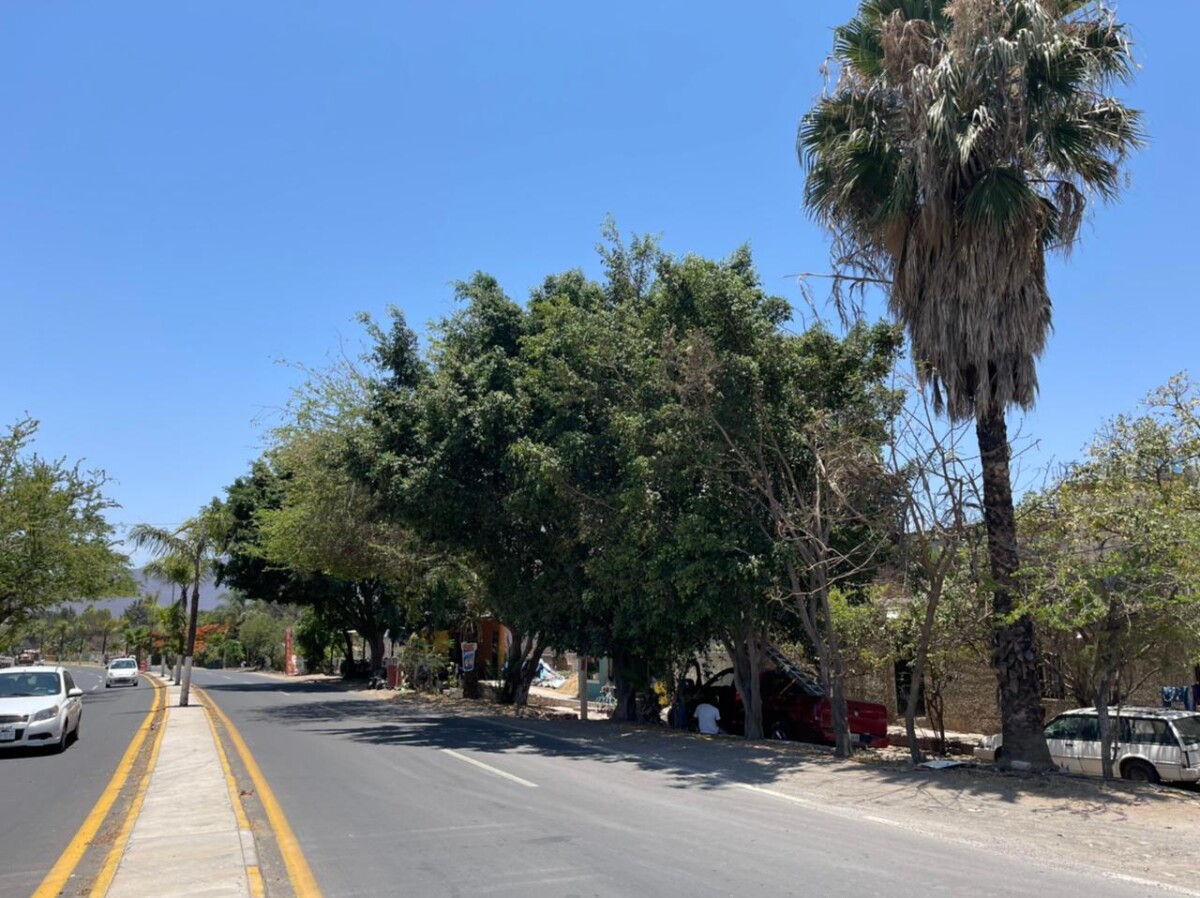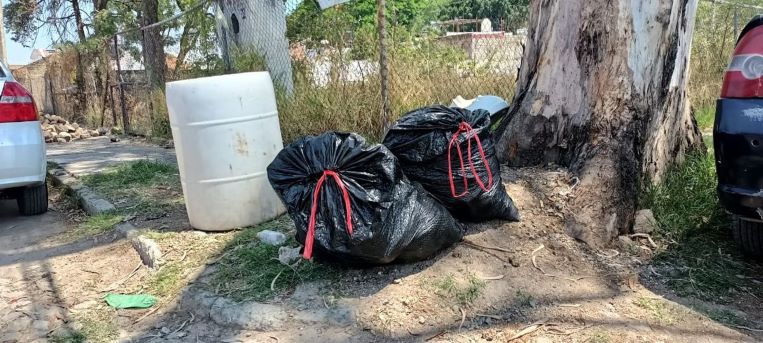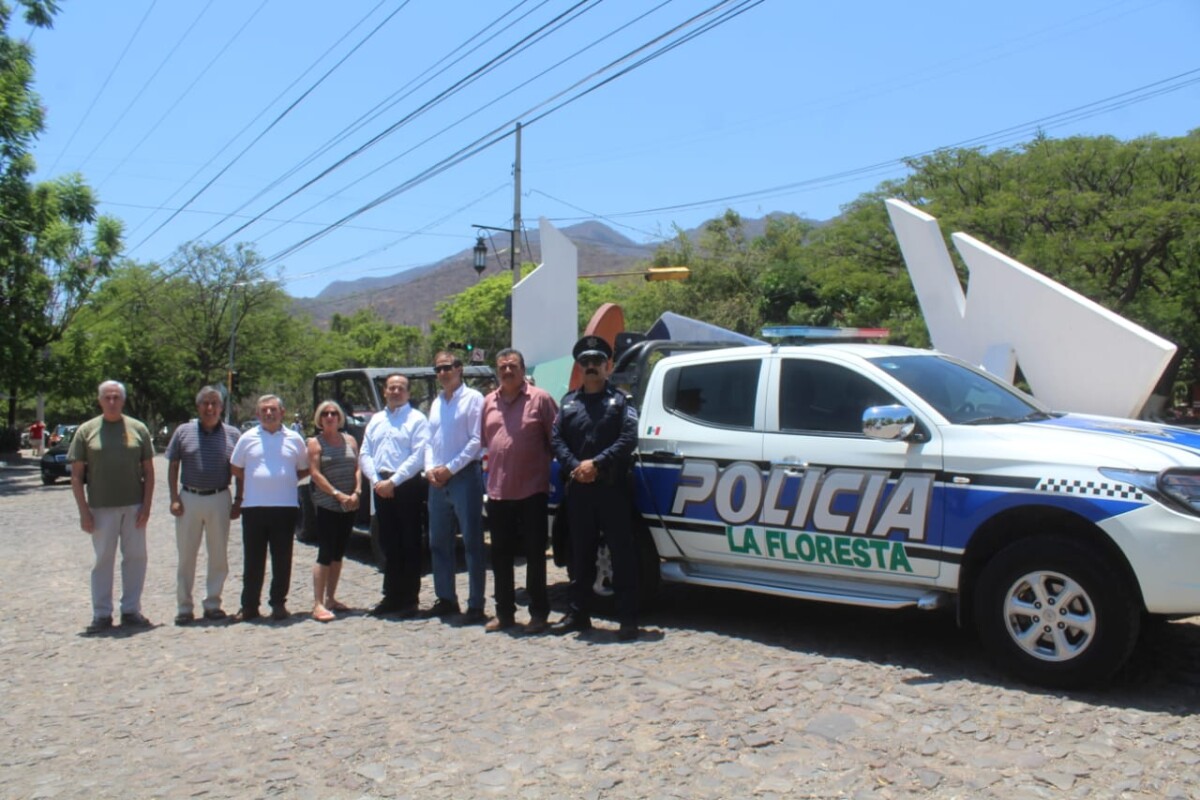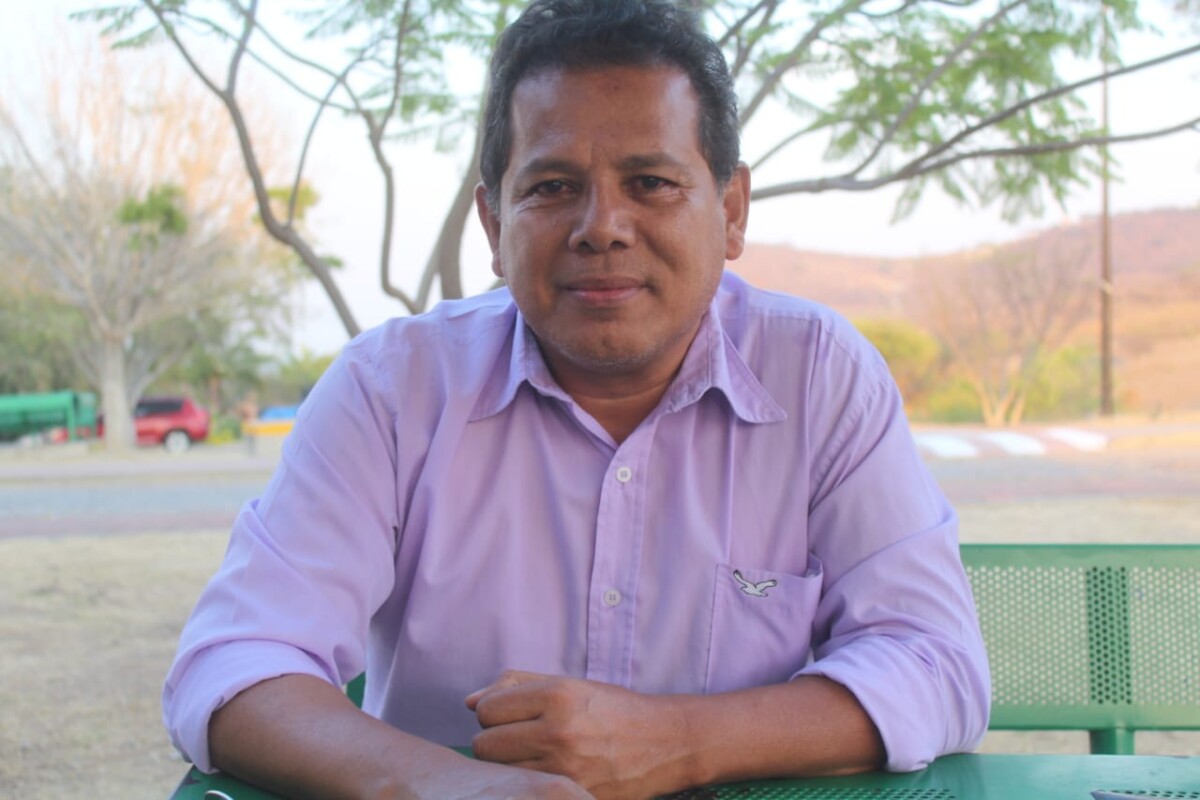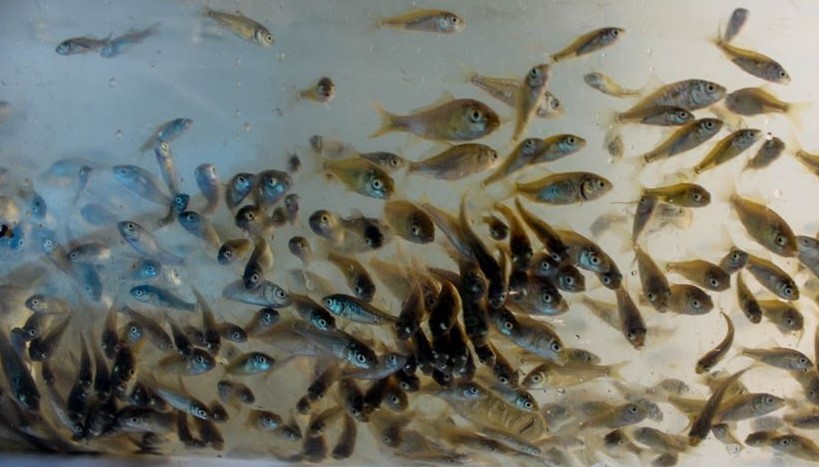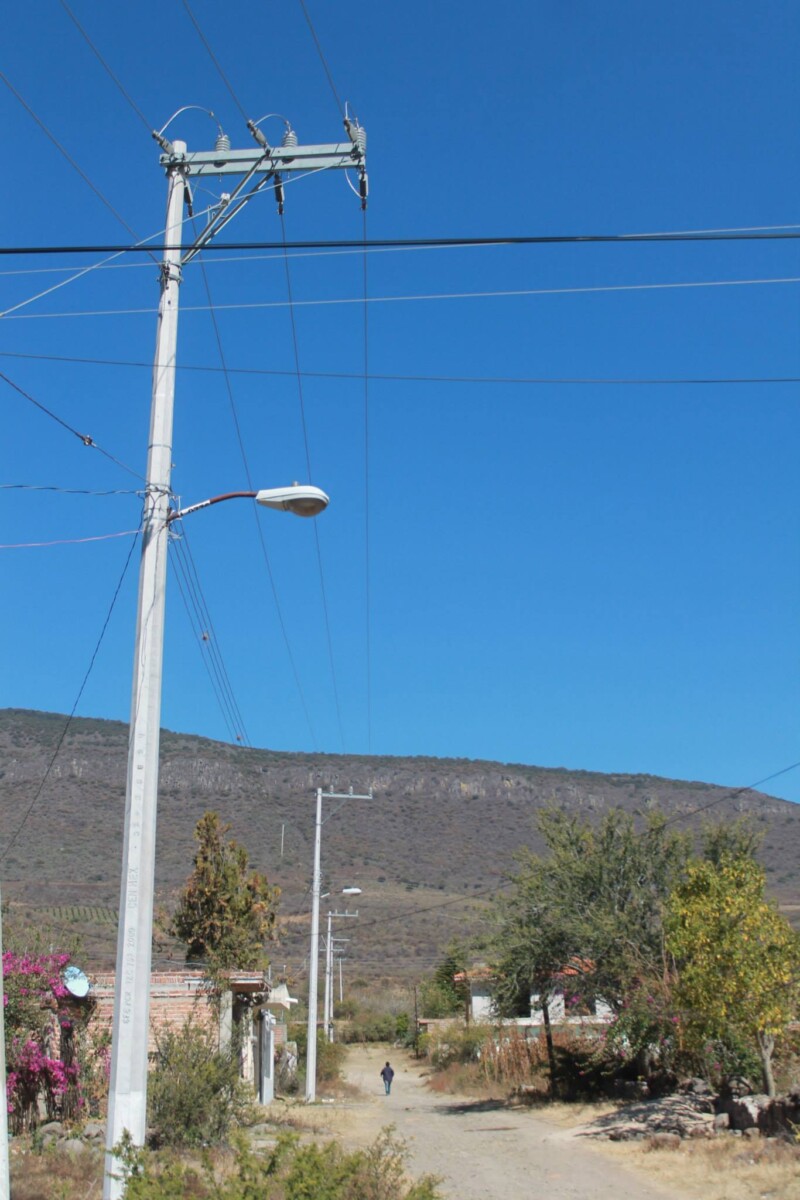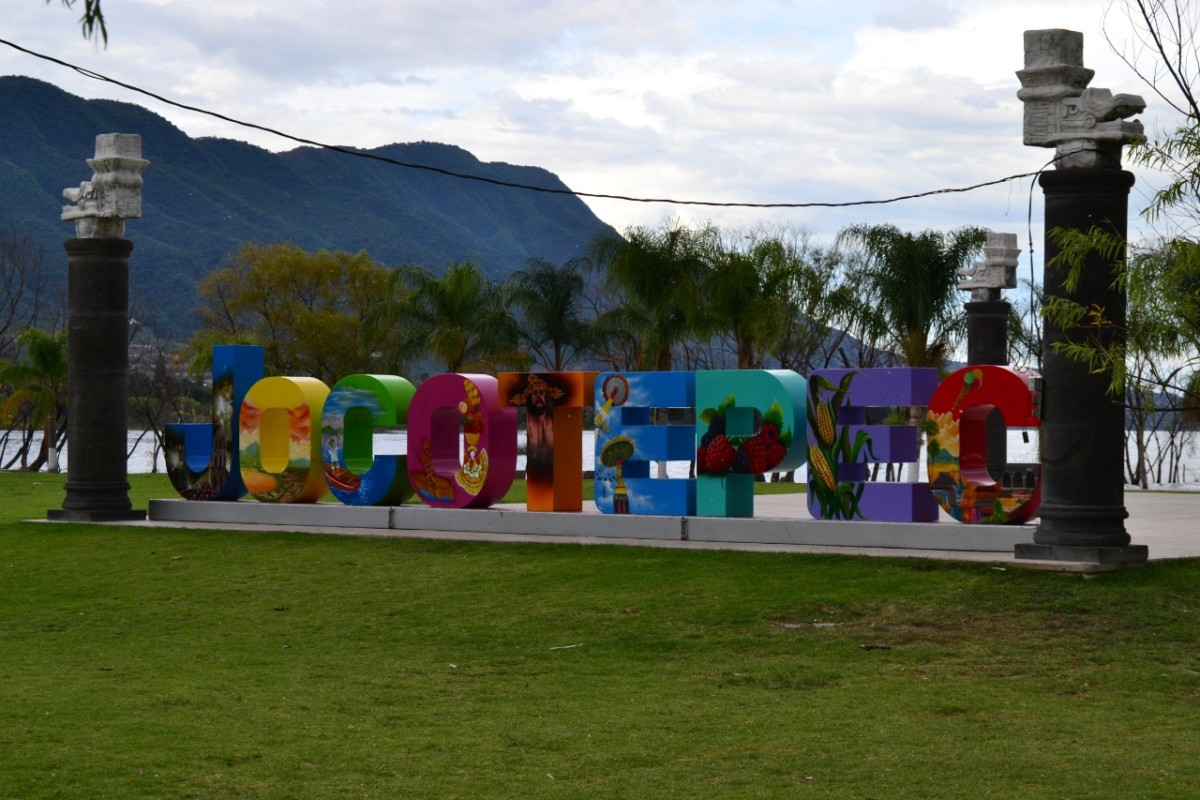noticias
SIOP to remove seven trees in Nextipac to construct bicycle path
Section of the Chapala-Jocotepec highway at Nextipac, where neighbors say ficus trees are slated for removal. Photo: Héctor Ruiz.
Héctor Ruiz Mejía (Jocotepec).- At least seven trees are in danger of being cut down, according to residents of the community of Nextipac, in Jocotepec.
Large trees of the species ficus carica, or fig tree, have been marked for removal by presumed workers of the Secretariat of Infrastructure and Public Works (SIOP) as part of the construction of the bicycle path connecting the municipality of Jocotepec with Chapala. According to the neighbors, such an action «would be a great loss because they [the trees] have been here for years and are important for all the neighbors.»
The residents also said that proposals have been presented to prevent the seven trees, each about 8 meters tall and 15 years old, from being removed, but no dialogue between the community and the alleged SIOP workers has yet occurred.
«We do not agree that these trees should be cut down; birds and animals inhabit them, and in addition they provide shade…we do not know what we are going to do if they are removed,» commented the opposing parties.
However, officials from SIOP assured residents that this was not the final project design. During the community meetings on that section, at the intersection of Libertad and 16 de Septiembre streets, by the soccer field, SIOP personnel had said that the trees would not be cut down.
Nevertheless, a little more than a week ago, the same SIOP personnel marked with a white line (which was erased after the rains) the route where part of the bicycle path should run and where the trees were ordered to be cut down.
Also, the neighbors stated that they have asked for help from the Directorate of Ecology and Environmental Protection of Jocotepec; however, according to Daniel Alejandro Garabito Espinoza, director of the agency, little can be done.
The official explained that this is a state-level issue and the only way to solve this matter is to reach a direct agreement between the neighbors and SIOP. «It is up to them to decide whether or not they want the trees to be cut down.»
The community complainants stated that they will not allow the trees to be uprooted «under any circumstances,» and they hope that a dialogue between the state and the citizens can be opened.
Opinion: From North to South
The federal government will hire 500 specialized Cuban doctors to provide coverage to marginalized areas. Photo: Courtesy.
Abigail Angélica Correa Cisneros
In response to the ongoing lack of medical personnel and the low participation of Mexican doctors providing service to marginalized areas, President Andres Manuel Lopez Obrador’s solution is to hire foreign doctors. Recently, the President informed the public that Mexico will hire 500 Cuban doctors.
According to the President, this is necessary because existing Mexican doctors refuse to provide healthcare in communities in marginalized areas. López Obrador estimated that there is a deficit of 50,000 health professionals. He blames this deficit on the previous administrations and the systemic corruption that prevailed for 36 years resulting in a failure to invest in health and education.
The President’s announcement triggered a wave of criticism from some doctors who attribute the problems to multiple factors, such as «insecurity, the lack of medical equipment in these areas, and the low salary offered to doctors for practicing their profession.» These comments are taken from interviews with doctors and from forums used by doctors.
Data from the National Occupation and Employment Survey (ENOE) for the second quarter of 2021 show that Mexico has 305,418 doctors, of which 54 percent are men and 46 percent are women. The data also show that of the total, 67 percent are general practitioners and 33 percent are specialists in some branch of medicine.
Mexican doctors say that there are enough doctors to meet needs, but that many are unemployed because the health system does not hire them. They add that in public hospitals, many are hired as temporary personnel to cover absences or vacations, and so they have no benefits and are also paid a miserable salary.
Furthermore, they recalled that during the pandemic, they responded to the government’s call to attend to those affected by Covid-19, and the long lines revealed the extent of unemployment in the sector. At the end of the emergency, they were laid off.
It is interesting to note, however, that data from an analysis conducted externally by the Organization for Economic Cooperation and Development (OECD), show that Mexico has just 2.4 doctors per 1,000 inhabitants compared to a worldwide average of 3.4. Additionally, Mexico has less than a third of the number of nurses and hospital beds per 1,000 inhabitants compared to the average. So, according to the standards of the OECD, Mexico ranks among the lowest countries regarding the ratio of healthcare workers to population.
Similarly, in terms of remuneration, Mexico is also lacking. For medical personnel, the average pay per hour worked is 122 pesos. Remuneration increases with an increase in level of education: those employed as doctors and who have a bachelor’s degree receive a monthly average of 17,422 pesos; those with a master’s degree receive an average of 21,041 pesos and those with a doctorate receive an average of 26,695 pesos per month.
The Covid-19 pandemic exposed in our country the highest excess mortality among OECD countries, as well as significant disruptions in the provision of other health services: in 2020 the pandemic caused a decrease in health care services and the number of face-to-face medical consultations fell by 9 percent compared to the previous year.
The crisis also highlighted the shortage of healthcare workers and the urgent need to invest more in the coming years to improve primary healthcare and disease prevention, as well as to strengthen the resilience and capacity of healthcare systems.
For 2022, the federal health sector budget increased 14.6 percent, with 824 thousand 181 million pesos allocated. Almost 10 percent (9.1%) of this increase is marked for the IMSS – Bienestar program. Depending upon which providers of services receive these funds and the efficiency with which the funds are spent, this increase could result in more equitable distribution of federal monies so that both the quality and availability of medical care and services improve for populations living in rural and marginalized areas.
The Center for Economic and Budgetary Research (CIEP) indicated in an analysis that the increase in the Federal health sector budget for 2022 for IMSS – Bienestar needs to result in an increase in the rate of care, and ambulatory and hospital medical assistance services, since these areas have all seen a downward trend starting before the pandemic. Since 2019, part of the decline in these health services has been due to the closure of medical units in urban areas.
Negative criticisms from Mexican healthcare workers are due to xenophobia and misinformation. The reality is that this support from Cuba, being promoted by our government, is indeed required. The medical care and attention provided by the 700 Cuban doctors who served in our country during the pandemic are evidence that the health of Mexicans living in remote areas will be in good hands, and that this type of collaboration is necessary.
Other important issues, which the government should not neglect, continue to be violence and the lack of opportunities in the country.
From the Center
By the close of 2021, Mexican farmers had achieved production of 268.4 million tons of food from the land, which marked an increase of 1.3 percent over the previous year. The Ministry of Agriculture and Rural Development reported that the increase in production was driven by higher yields of grains and oilseeds, used in both industry and as fodder. The Ministry’s report highlighted that the area sown during the agricultural year 2021 constituted 21,584,000 hectares, which generated a production volume with a value of 750,778,000 million pesos; 8.3 percent more compared to the previous year (693,072,000 million pesos).
Translated by Rebecca Zittle
Garbage piling up in Chapala neighborhoods
Large bags of trash sit along a chain link fence. Credit: Jazmín Stengel.
Jazmín Stengel (Chapala).- Neighbors complain that garbage is still not being collected in some Chapala neighborhoods including San Juditas, San Miguel, La Purísima and Las Redes.
In response, the Chapala municipal government explained that the company in charge of garbage collection in the municipality, GIRRSA, has one broken-down truck. The broken truck is negatively impacting their ability to maintain the regular garbage pickup schedule.
In the interim, municipal employees are working to pick up the slack.
Translated by Amy Esperanto
Clearing of Ajijic bridges and streams almost complete
Bridge near the cemetery being cleaned by hand by delegation personnel. Photo: Sofia Medeles.
Sofía Medeles (Ajijic).-The cleaning and clearing of bridges and streams in Ajijic is about to be finished, said Maximiano Macías Arceo, in charge of the office.
The bridges in the western zone of the delegation are already cleared, and the excavating machines are only giving the «final touches,» he commented.
The bridges that still need to be cleaned include one located between Rio Zula and Tio Domingo, which Macias Arceo defined as critical due to the obstruction it presents. It passes between several houses and runs into a wall at the hotel «La Joya del Lago» which cuts its course. It has already been reported and will be reviewed by the Urban Development Department.
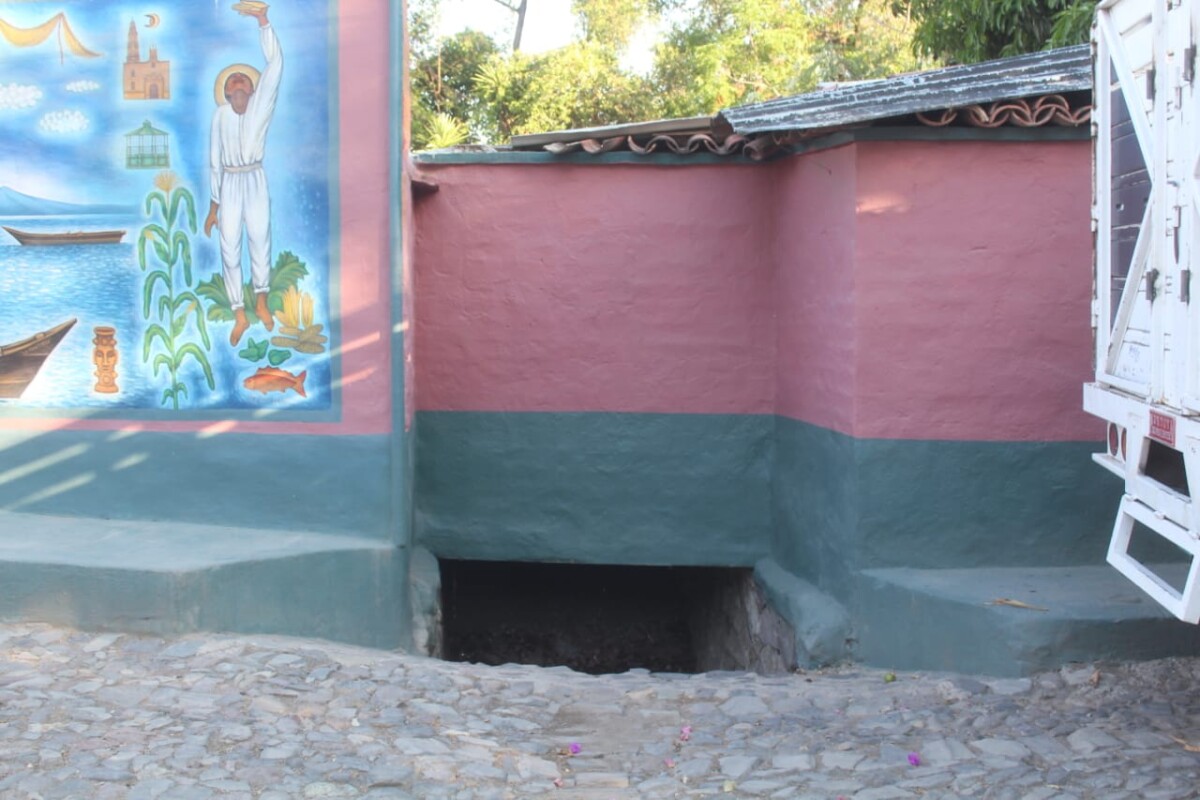
Bridge between Rio Zula and Tio Domingo, which is still obstructed by debris from the mudslides. Photo: Sofia Medeles.
The second is located in the area known as «three bridges,» which only needs the usual drainage since it was not affected by the landslides of last October 2021.
«Most of them have already been cleared, there is still a bit of work to be done, but they are free now, they are ready for the rainy season and will not have any problems,» concluded Maximiano Macias.
However, as of Sunday, 22 May,Laguna observed large boulders and rocks in the underpass at Sendero Christina, which serves several farms and ranches. The area was surrounded by security tape and large piles of debris had been cleared to one side of the road..
Residents of La Floresta loan patrol car to Chapala
The patrol car was transferred on May 19. Photo: Sofía Medeles.
Sofía Medeles (Ajijic).- A patrol unit was given on loan to the Government of Chapala by the residents of La Floresta. They were responsible for acquiring the vehicle for the use and care of the subdivision and nearby areas.
The car is labeled with the logos of the municipal police and the subdivision. The neighborhood association president, Fernando Plata, said that the car cost more than 400 thousand pesos (about US$20,000). The car was paid for by residents of La Floresta.
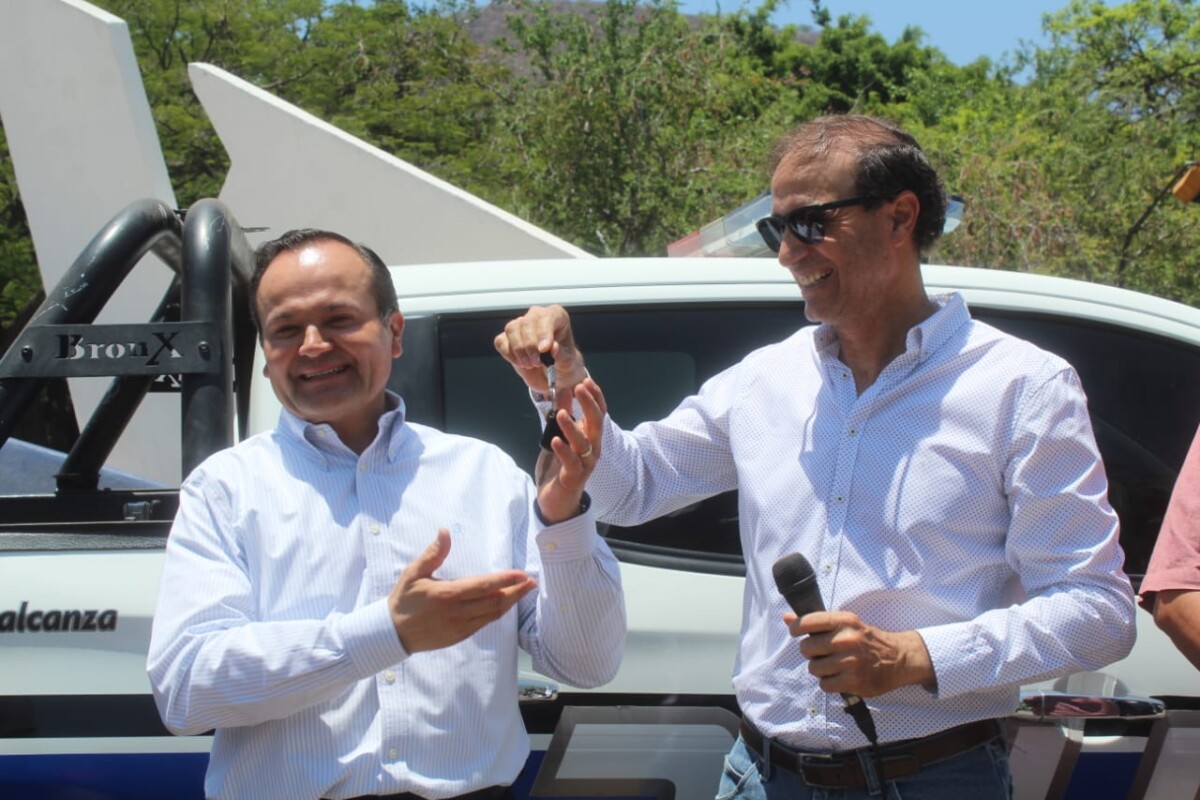
The moment when the neighborhood association president, Fernando Plata, handed the key to the municipal president, Alejandro Aguirre. Photo: Sofía Medeles.
Plata also pointed out that the municipal government provides the officers who will carry out the patrol work in the area and the surrounding streets. In case of emergencies, the car can be used in other parts of the municipality.
During the meeting held on May 19, Fernando Plata spoke with the municipal president, Alejandro Aguirre Curiel, about upcoming projects to improve the flow of traffic on the highway and pedestrian circulation in the area.
The formal handover ceremony, which took place at the La Floresta sculpture on the Chapala-Jocotepec highway, was also attended by acting Ajijic delegate Maximiano Macias Arceo, Sergio Conzuelo Ramirez, commander of the municipal police, and members of the board of directors of the subdivision.
Bernabé Robledo: a teacher dedicated to Ajijic
Bernabé Robledo, currently in charge of CETAC Ajijic. Photo: Sofía Medeles.
Sofía Medeles (Ajijic).- For almost 30 years, Professor Bernabé Robledo has not only been in charge of educating young people in the classroom but also teaching them to be empathetic citizens, while being an activist for the land he lives on.
Bernabé was born in Ajijic. He is the son of farmers and attended basic education in the delegation, until high school, when he studied at the Center for Technological Studies in Continental Waters (CETAC 01) in Jocotepec. Later, he studied food engineering at the Mazatlán Technology, Sinaloa. He also earned a master’s degree from Ocotlán and a doctorate in Education.
After working in an industrial food production company, in 1996 he decided to become a teacher; his first position as a professor was at the Center for Technological Studies of the Sea (CETMAR) in Mazatlán.
In 1996 he joined the CETAC Jocotepec, then he became one of the first members of the Mario Molina Institute which studies sustainability, as well as having been a professor at the National College of Technical Professional Education (CONALEP) in Chapala.
One of his achievements which he speaks of as a father would speak of his prodigal child, is the CETAC Ajijic, an extension of the Jocotepec campus, which Robledo managed. He went to great lengths to acquire the property and to request donations to repair the school that was abandoned for at least 15 years, and has been working since 2019, and in his words, has been “shaped to meet the needs of the people of Ajijic.”
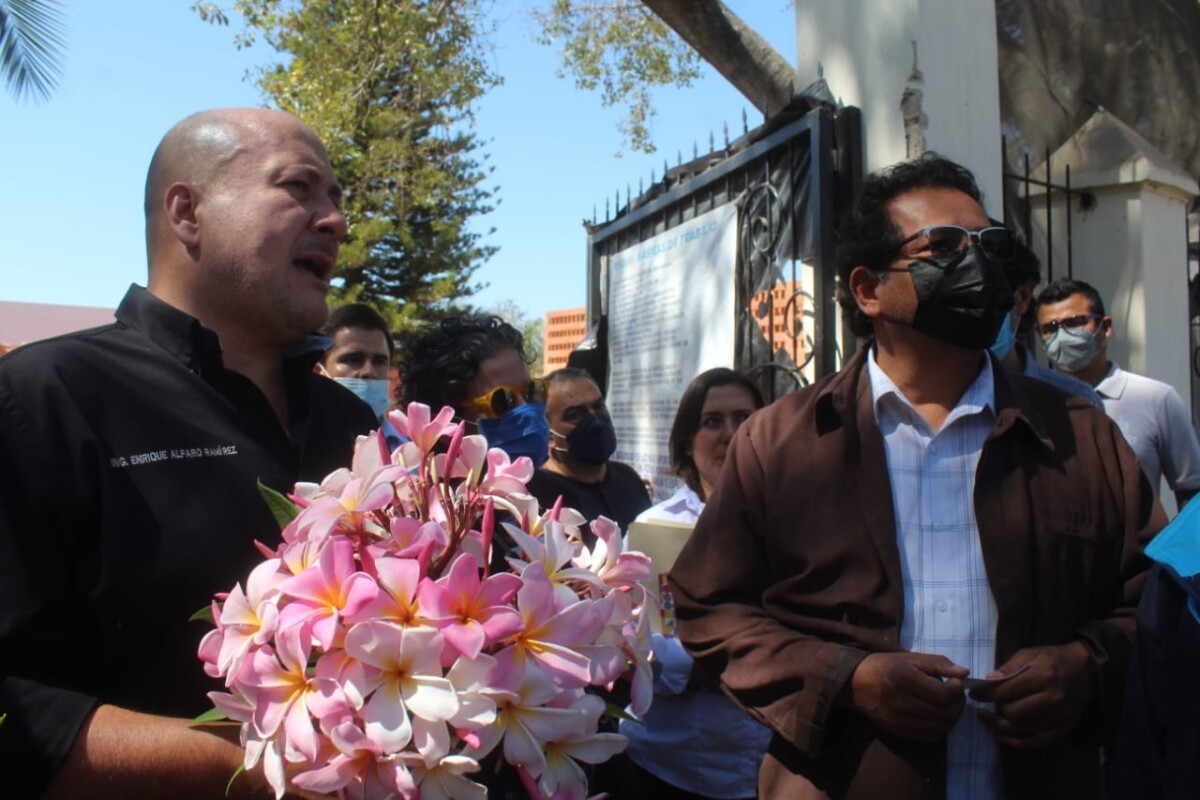
Bernabé presenting a request for help to Governor Enrique Alfaro Ramírez. Photo: Sofía Medeles.
«There are many private schools in Ajijic, but none that are public that meet the vocational needs of the region. Ajijic is a town that has approximately 12,000 citizens, and has a tourist economy, which is why we thought training in businesses related to the settlement of foreigners and tourists is a perfect fit,» commented the professor.
In addition to continuing with the improvement of the campus, which he said could have the potential to be one of the most beautiful schools in Lakeside, one of his most important goals is to secure the campus in the campus where it is located, which was loaned to it by the 2018-2021 administration. He also spoke of the exponential growth that has taken place since the beginning, with 115 students and its first generation about to graduate.
Bernabé Robledo commented that his taste for teaching at the high school level arose for several reasons, one of them being how his life has been coupled to the needs that young people have at this age and that makes it easier for him to communicate with them, and to the nobility he finds in this age range.
«At this age, you are finishing shaping the citizens about to be sent to society. I have found satisfaction, especially in their nobility. For example, when we were fixing up the CETAC playground, one of the laziest youngsters helped and put all his effort into handling the concrete mixing equipment. He gave and gave, until when he finished, he fell exhausted to the ground. He was a 16 or 17 year old kid who decided to help, and thanks to him, as well as to the other youngsters, CETAC has made progress,” he said.
Professor Berna, as he is also known, not only says he is committed to education, but also to activism, which he has engaged in on multiple occasions with his students.
«I am a great admirer of Paulo Freire, educator of America, and I agree with his philosophy that the teacher by himself is already a social transformer. I don’t find any conflict between activism and teaching, I can’t conceive of one without the other. I get tired, but I don’t get angry, I don’t work for a salary, but for an ideal. If you don’t feel that way, it may not be your vocation,» he said firmly.
On the other hand, he has always advised his students to pursue cultural activities, since, his vision is that he seeks young people to realize culture and empathy, that they feel proud and love these teachings, adding that «we are rich in culture, we do not have to envy any other culture.»
Finally, he dedicated a few words to the future teachers: in this profession they are not going to get rich so it is something they must love, since it is a social work owed to the community.
Translated by Christalle Dalsted
150,000 tilapia hatchlings released into Lake Chapala
Tilapia hatchlings in a plastic bag before being released. Photo: Archive.
Editor.– As part of the commitment of the Tizapán Aquaculture Center to donate 500 thousand fish hatchlings to reactivate fishing activity in Lake Chapala, the first delivery was made by the Secretary of Agriculture and Rural Development (SADER) Jalisco, and this first batch delivered was 150 thousand tilapia hatchlings in Jamay.
This donation of fish hatchlings benefits the 61 fishing organizations on the Chapala shore, made up of 1,661 people. Jamay and Poncitlán are the municipalities with the most fishing organizations, with 15 each. Chapala and Ocotlán have eight cooperatives, Tizapán six, Tuxcueca five and Jocotepec has four fishermen’s groups.
Translated by Paul Weeks
With rain, ‘blackout’ season begins in Jocotepec
Citizens denounce the lack of maintenance of public lighting by the CFE. Photo: Courtesy.
Héctor Ruiz Mejía (Jocotepec).- The rainy season has started and with it the power blackouts throughout the municipality of Jocotepec. On May 15, through a communiqué shared on official networks, the Jocotepec City Hall alerted citizens about the season of power outages due to weather conditions.
Since the rainy season officially began, the government announced that the season of “las caídas de cuchillas” [«blades dropping»] is coming, which is when fuses are set to protect the transformer from power surges.
Therefore, the community was urged to remain alert about drinking water pumping equipment in the houses and to close faucets, especially at night. This measure will avoid the waste of water that has been observed in the last few days when the electric power goes off.
However, drinking water has not been the only problem for some residents of the community. Since the winds began, neighbors in the neighborhood of La Purísima, north of town and Nextipac, have already reported problems.
«The first few days we had between 15 and 20 blackouts in an hour and since yesterday, with any wind, it goes out and it takes longer and longer to return,» said one of the neighbors.
Although this situation has been blamed on weather and the neighbors consider this to be a possible cause for the blackouts, the fact that «any little breeze» deprives them of service and denotes a lack of maintenance on the part of the Federal Electricity Commission (CFE).
They also added that they have never seen CFE provide adequate maintenance to the light poles and are concerned since «we are just starting the rainy season and we are already struggling like this.»
Translated by MaryAnne Marble
Prospecta INE división del distrito 17
El cambio distrital se debe a la disminución de población en la ZMG y el crecimiento en municipios del interior de Jalisco. Foto: Cortesía.
Redacción.- La proyección del nuevo mapa distrital que propone el Instituto Nacional Electoral (INE) para la región del Lago de Chapala para este 2022 contempla la división de los municipios ribereños que quedarían en los distritos dos, cuatro y ocho.
Chapala se ubicaría en el distrito dos junto a Jocotepec, Ixtlahuacán de los Membrillos, Poncitlán, Ocotlán, Zacoalco de Torres, Acatlán de Juárez y Villa Corona.
En el distrito cuatro estaría integrado por las entidades de Jamay, La Barca, Degollado, Atotonilco el Alto, Ayotlán, Jesús María, San Diego de Alejandría, San Julián, San Miguel el Alto, Jalostotitlán y Arandas.
Mientras que el distrito ocho quedaría conformado por Tototlán, Zapotlán del Rey, Tepatitlán, Ixtlahuacán del Río, Zapotlanejo, Acatic, Yahualica de González Gallo, Mexticacán, Valle de Guadalupe, San Ignacio Cerro Gordo y Juanacatlán.
Aun con estos cambios Jalisco se mantendría con 20 distritos estatales y federales, el proyecto para la nueva conformación de los distritos, se entregaron a los partidos políticos acreditados en las Comisiones de Vigilancia y los Institutos Electorales locales para que realicen su análisis y presenten observaciones para luego someterlo a la consideración del Consejo General del INE.
El proyecto para la nueva conformación de los distritos electorales se realiza debido a la disminución de la población en distritos del Área Metropolitana de Guadalajara (AMG) y el crecimiento de municipios como Ixtlahuacán de los Membrillos.
El proyecto inició en el 2021 y concluirá en el 2023 previo al periodo electoral 2023 – 2024.
Aprueba Jocotepec talleres de urbanización que beneficiarán a la región ribereña
Letras monumentales en el malecón de Jocotepec. Foto: Archivo.
Redacción.- El ayuntamiento de Jocotepec aprobó la realización de los talleres “Isocare”, organización enfocada en la urbanización. Dentro de diferentes áreas del municipio se pretende hacer un ordenamiento territorial, en el cual el Gobierno del Estado de Jalisco trabaja.
El taller abordará temas de movilidad, habitacional, inversión hotelera, restaurantes y de turismo, que podrían beneficiar a los alcaldes de Chapala, Tuxcueca y Tizapán, según lo expuesto el jueves 12 de mayo, en la décima sesión ordinaria de cabildo.
El alcalde, José Miguel Gómez López explicó, que ésta organización puede crear una infraestructura de alta calidad para Jocotepec y municipios cercanos.
“¿Qué nos van a decir?; cuáles son las sugerencias en temas de movilidad, habitacional, inversión hotelera, restaurantes y tema de turismo. Te dan siete puntos donde platica con los presidentes de Chapala, Tuxcueca y Tizapán para reunirnos con las personas adecuadas”.
Dentro de este proyecto se pretende invertir cien mil pesos entre todos los municipios con la finalidad de crear un equilibrio entre estos, donde el gobierno de Jocotepec brindará una seguridad a la población en la que no se afecte su naturaleza y espacios ecológicos.
Gómez López mencionó que dentro de esta organización realizan estudios de medio ambiente con la finalidad de frenar los desarrollos que afectan a dicho sector en el municipio.
“En el taller lo que nos van a decir es que en estas zonas pueden generar desarrollos de este tipo de esta densidad y se requiere ampliar este tipo de carreteras. Te hacen un estudio completo de la urbanización que se puede hacer sustentable con el taller y el dictamen nosotros podemos generar los planes parciales a la medida de cada espacio”, detalló el edil.
© 2016. Todos los derechos reservados. Semanario de la Ribera de Chapala
